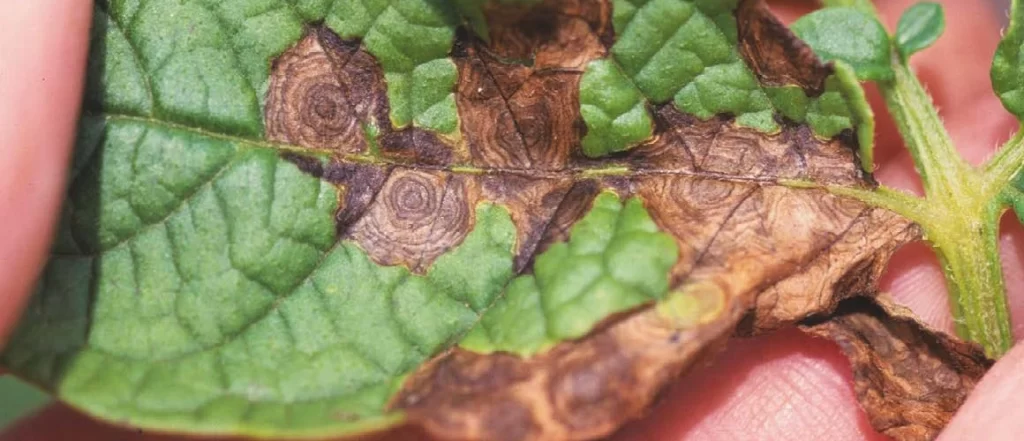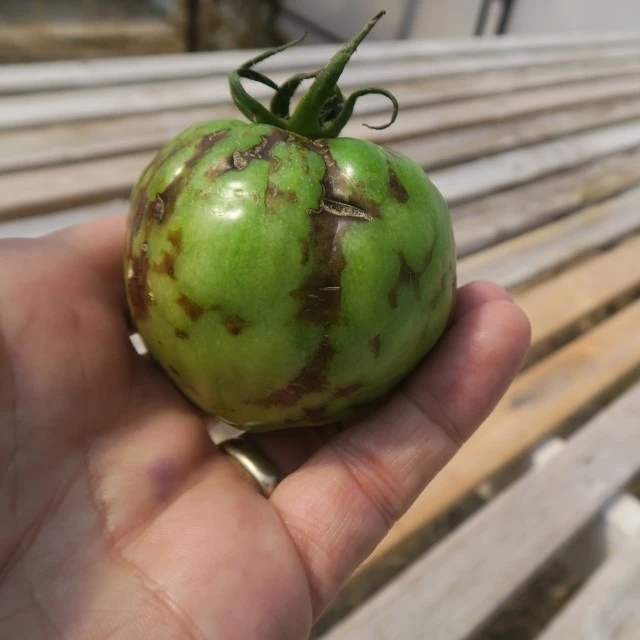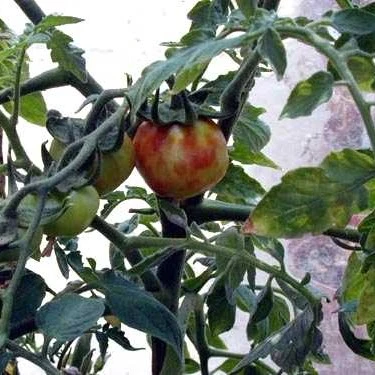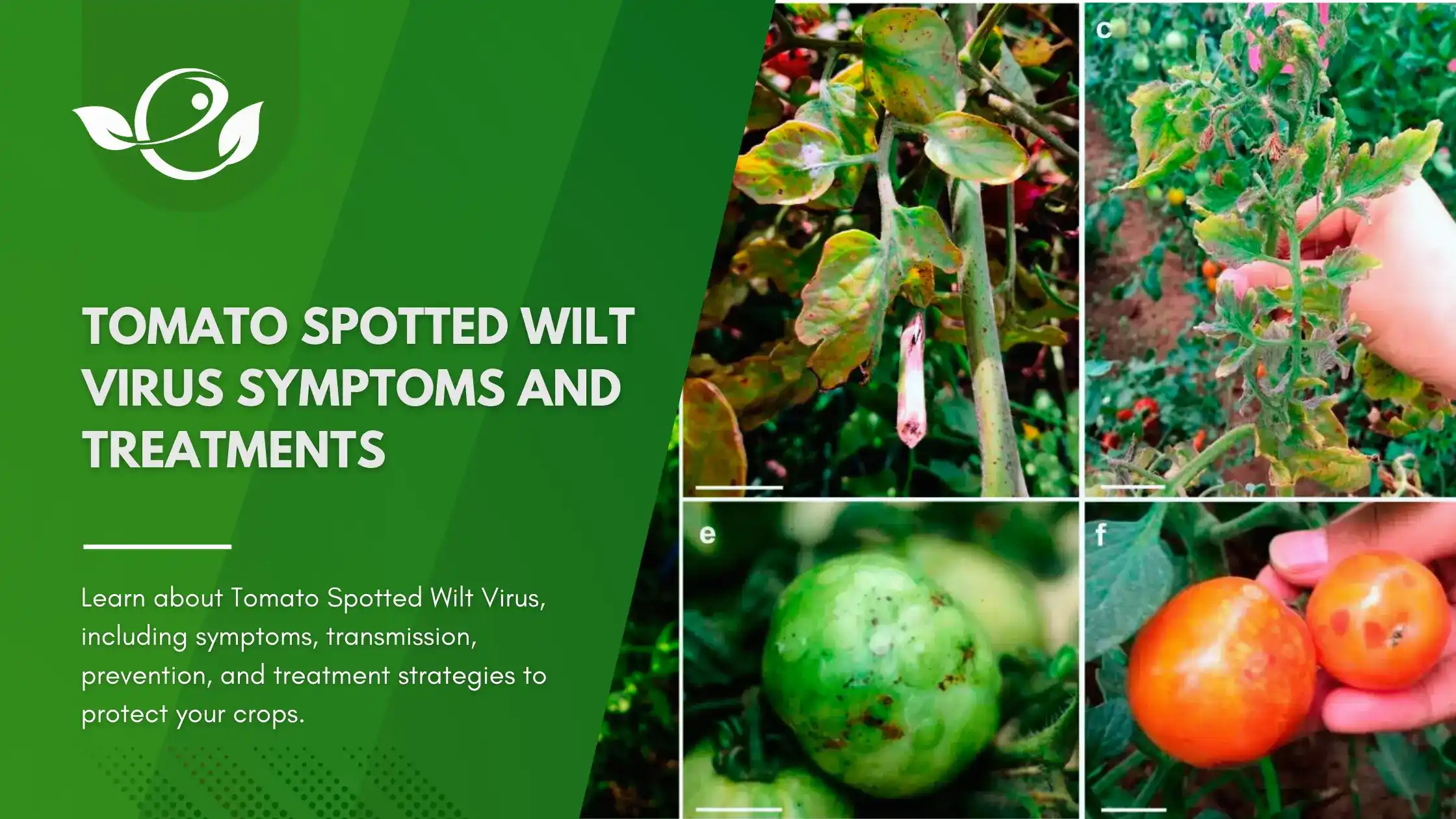Table of Contents
In the verdant world of agriculture, where the health of crops dictates the prosperity of harvests, few adversaries are as formidable as the Tomato Spotted Wilt Virus (TSWV). This insidious pathogen, often lurking unnoticed in the early stages of its invasion, has the power to decimate tomato crops, leaving behind a trail of spotted, wilted, and ultimately unmarketable produce. Farmers and gardeners who once nurtured vibrant tomato plants, full of promise and potential, find themselves grappling with the stark reality of reduced yields and compromised fruit quality.
TSWV is not just another viral nuisance in the garden; it represents a significant threat to global tomato production. Originating from the orthotospovirus genus, it’s adept at exploiting the vulnerabilities of plants, swiftly spreading from one to another through its tiny, but efficient, vectors—thrips. As these minute insects move from plant to plant, they unwittingly become carriers of devastation, transmitting the virus to healthy crops and setting off a chain reaction that can be challenging to halt.
Managing TSWV requires a comprehensive understanding of its symptoms, transmission, and effective treatment options. It’s not enough to merely react to its presence; proactive measures must be taken to prevent its spread and mitigate its impact. From identifying the earliest signs of infection to employing integrated pest management strategies, there are numerous steps that can be taken to protect tomato plants from this relentless foe. In this guide, we’ll delve deep into the symptoms and treatment of Tomato Spotted Wilt Virus, providing you with the knowledge and tools to safeguard your crops and ensure the health of your tomato plants.
Understanding Tomato Spotted Wilt Virus (TSWV)
What is Tomato Spotted Wilt Virus (TSWV)?
Tomato Spotted Wilt Virus (TSWV) belongs to the genus Orthotospovirus, which includes a range of plant viruses notorious for their economic impact on agriculture. first described in Australia in 1915, and its viral nature was determined in 1930, TSWV has since spread globally, affecting a variety of crops, including tomatoes, peppers, potatoes, and even ornamental plants. This virus is characterized by its broad host range and its ability to mutate, which complicates management efforts and makes it a perpetual concern for growers.
Tomato Spotted Wilt Virus is primarily transmitted by thrips, tiny insects that act as vectors. Once a thrip feeds on an infected plant, it carries the virus for life, transmitting it to each plant it subsequently feeds on. This virus is especially challenging to manage due to its ability to persist in both the insect vector and plant hosts, surviving through crop rotations and other traditional control measures.

Transmission and Spread
Tomato spotted wilt virus is transmitted by various species of thrips, including the western flower thrips (Frankliniella occidentalis), the onion thrips (Thrips tabaci) and the chilli thrips (Scirtothrips dorsalis). TSWV is also active in the thrips vector and can transmit it persistently. Nymphs that acquire the virus by feeding on infected plants will retain the ability to transmit it for the remainder of their lives. However, it cannot be passed from infected females to the eggs. The virus has a very wide host range, including tomato, pepper, potato, tobacco, lettuce, and many other plants. The lifecycle of thrips includes rapid reproduction, which accelerates the spread of TSWV across a field or greenhouse.
Thrips thrive in warm, dry conditions, making them particularly problematic in certain climates and during specific seasons. In addition to thrips, other factors contribute to the spread of TSWV, including:
- Environmental Conditions: Warm temperatures and low humidity favour thrips populations.
- Host Range: Tomato Spotted Wilt Virus infects over 1,000 plant species, providing ample opportunities for the virus to persist and spread.
- Human Activity: The movement of infected plants, tools, and equipment can inadvertently spread the virus to new areas.
Given these factors, managing the Tomato Spotted Wilt Virus requires an integrated approach that addresses both the virus and its vectors.
Symptoms of Tomato Spotted Wilt Virus
Recognizing the symptoms of Tomato Spotted Wilt Virus is crucial for effective management. The virus manifests in various ways, depending on the host plant and environmental conditions. However, many plants exhibit a distinct set of symptoms that can help in early identification and intervention.
Early Symptoms
- The initial symptom is the blighting of young leaves with purple or brown spots on the leaves. It usually appears on the upper part of the plant. Purple streaks and small dark brown spots appear on stems and young leaves, sometimes forming concentric rings.
- These spots may appear water-soaked or slightly raised, resembling the early signs of other common plant stresses or diseases.
- As the infection progresses, leaves may begin to curl or twist, showing signs of distortion that are often mistaken for herbicide damage or nutrient deficiencies.
Advanced Symptoms
As TSWV progresses, the symptoms become more pronounced and detrimental to the plant’s health:
- Concentric Rings: One of the hallmark symptoms of Tomato Spotted Wilt Virus is the development of concentric rings or target-like patterns on the leaves. These rings can vary in color from pale yellow to dark brown, depending on the severity of the infection. As they coalesce, they cover large patches of the blade, eventually leading to necrosis of the tissues. Dark brown streaks may be visible on stems and petioles.
- Necrotic Spots: Growing tips are usually severely affected by systemic necrosis. Leaves and fruits may develop necrotic (dead) areas that appear as dark, sunken spots. These lesions can spread, causing extensive damage to the foliage.
- Stunted Growth: Infected plants often exhibit stunted growth or may exhibit one-sided growth, with reduced vigor and a general wilting appearance, despite adequate water and nutrients.
- Chlorosis: Leaves may turn yellow (chlorosis), particularly around the veins, giving them a mottled or mosaic-like appearance.

Impact on Fruit Quality
TSWV significantly impacts the quality of tomato fruits, making them unmarketable. Infected fruits may show symptoms such as:
- Spotted Fruits: Fruits develop rings, spots, or blotches that render them unsightly and unsuitable for sale.
- Deformation: The virus can cause irregular growth patterns in fruits, leading to deformed fruits that do not meet commercial standards.
- Reduced Yield: Infected plants produce fewer and smaller fruits, severely impacting overall yield.



Severely infected plants bear immature tomatoes with mottled, light green rings and raised centres. On ripe, red fruits, striking brown rings accompanied by chlorotic spots and blotches make fruits unmarketable.
Visual Guide
Including images of infected plants, leaves, and fruits can be invaluable for identifying Tomato Spotted Wilt Virus. Visual aids help distinguish TSWV symptoms from those of other common diseases, such as bacterial wilt or early blight.
Diagnosis of Tomato Spotted Wilt Virus
Field Diagnosis
Field diagnosis is typically based on visual inspection of symptoms. The distinctive spotted leaves, concentric rings, and general wilting are strong indicators of TSWV presence. However, these symptoms can sometimes be confused with other plant diseases or abiotic stress factors, such as nutrient deficiencies or chemical damage. To differentiate TSWV from other conditions, it is important to consider the overall pattern of symptoms, the presence of thrips, and the environmental conditions. If Tomato Spotted Wilt Virus is suspected, further diagnostic testing should be conducted to confirm its presence.
Laboratory Testing
For definitive diagnosis, laboratory testing is essential. Several diagnostic methods are available:
- Enzyme-Linked Immunosorbent Assay (ELISA): A commonly used test that detects the presence of viral proteins in plant tissues.
- Polymerase Chain Reaction (PCR): This technique amplifies viral genetic material, allowing for precise identification of TSWV.
- Lateral Flow Devices: Similar to a pregnancy test, these portable devices provide quick on-site results.
Accurate diagnosis ensures that appropriate management strategies are employed, avoiding unnecessary treatments that may not be effective against Tomato Spotted Wilt Virus.
Treatment and Management of Tomato Spotted Wilt Virus
While there is no cure for TSWV once a plant is infected, several management strategies can help reduce the impact of the virus on tomato crops. Effective control involves a combination of cultural, chemical, and biological approaches.
Cultural Practices
Cultural practices play a significant role in managing TSWV:
- Crop Rotation: Rotating crops with non-host plants can help break the cycle of infection. Avoid planting tomatoes in the same location year after year.
- Resistant Varieties: Using TSWV-resistant tomato varieties can significantly reduce losses. These varieties are bred to withstand viral infection and exhibit fewer symptoms.
- Sanitation: Remove and destroy infected plants to prevent the virus from spreading. Clean tools and equipment regularly to avoid cross-contamination.
Chemical Controls
Always consider an integrated approach of preventive measures together with biological treatments if available. Due to the high reproductive rates and their life cycles, thrips have developed resistance to different classes of pesticides. Effective contact insecticides include azadirachtin or pyrethroids, which in many products are combined with piperonyl butoxide to enhance their effect.
- Reflective Mulches: Reflective mulches can deter thrips by altering light conditions, making the environment less favourable for the insects.
Biological Controls
Some predatory mites feed on larvae or pupae of thrips and are commercially available. For varieties that attack the leaves and not the flowers, try neem oil or spinosad, especially on the undersides of the leaves. Spinosad application is very effective but can be toxic to certain natural enemies (e.g., predatory mites, syrphid fly larvae, bees) and should be avoided during flowering time. In case of flower thrips infestation, some predatory mites or green lacewing larvae could be used. A combination of garlic extracts with some insecticides also seems to work well.
- Predatory Insects: Predators such as minute pirate bugs (Orius spp.) and lacewing larvae can effectively reduce thrips numbers.
- Biopesticides: Products containing entomopathogenic fungi or bacteria can target thrips without harming beneficial insects.
Integrated Pest Management (IPM)
An Integrated Pest Management (IPM) approach combines various strategies for comprehensive TSWV control:
- Monitoring: Regularly monitor crops for signs of thrips and early TSWV symptoms. Use sticky traps and visual inspections to assess thrips populations.
- Threshold Levels: Set action thresholds based on thrips counts and TSWV prevalence. Intervene when thrips populations reach levels that could pose a significant risk of TSWV spread.
- Early Intervention: Implement control measures at the first sign of thrips or TSWV to minimize damage.
Prevention Strategies
Prevention is the most effective way to manage TSWV, as it stops the virus from establishing itself in the first place.
Preventive Measures
Implementing preventive measures can greatly reduce the risk of TSWV:
- Use transplants from nurseries that have proper management for thrips and TSWV.
- Avoid planting near alternative hosts or plants infected with the virus.
- Plant resistant tomato varieties, as they do not require insecticide applications against thrips to control the dispersal of the virus.
- Use sticky traps over a large area for mass-catching.
- Control weeds in and around the field by using highly reflective UV mulch (metalized mulch) to ward off the thrips.
- Remove infected plants and any plant debris and destroy them.
- Keep plants well irrigated, and avoid excessive applications of nitrogen fertilizer.
Thrips Management
Managing thrips populations is essential for preventing TSWV:
- Inspect transplants thoroughly for the presence of thrips.
- Reflective Mulches and Traps: Reflective mulches can repel thrips, while blue sticky traps attract and capture them.
- Timely Insecticide Applications: Apply insecticides at critical times, such as before flowering when thrips populations typically surge.
Greenhouse Management
Greenhouse environments present unique challenges and opportunities for TSWV management:
- Screening: Use fine mesh screens to prevent thrips from entering greenhouses.
- Environmental Control: Manage temperature and humidity to create less favourable conditions for thrips.
- Greenhouses could be sterilized with steam between plantings.
Conclusion
Tomato Spotted Wilt Virus is a formidable adversary, capable of causing significant damage if left unchecked. Its broad host range, adaptability, and reliance on thrips for transmission make it a persistent problem for growers worldwide. Understanding the symptoms of TSWV—such as spotted leaves, stunted growth, and mottled fruits—is crucial for early detection and management.
Effective treatment of TSWV revolves around integrated management strategies that include cultural practices, chemical controls, and biological methods. Emphasizing prevention through the use of resistant varieties, good sanitation practices, and vigilant thrips management can greatly reduce the risk of infection. By adopting a proactive, multifaceted approach, growers can safeguard their crops from TSWV and ensure a healthier, more productive harvest.
The fight against TSWV is ongoing, but with knowledge, vigilance, and the right strategies, it is a battle that can be won. As we continue to learn more about this virus and refine our control methods, the goal remains clear: to protect our crops, preserve our yields, and maintain the vitality of our agricultural systems.








